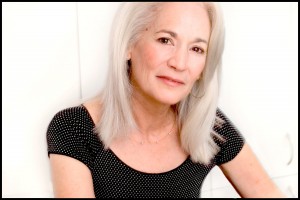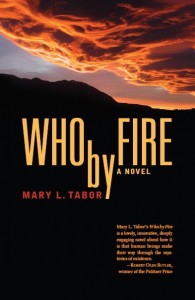

JCC Clip from Mary Tabor on Vimeo.
 Here’s what Richard Kramer, writer and producer of the TV show Thirtysomething, among others, and author of These Things Happen, a novel he wrote and has adapted for an HBO series produced by Oprah Winfrey wrote about Mary L. Tabor’s sensual, sensitive novel, WHO BY FIRE.
Here’s what Richard Kramer, writer and producer of the TV show Thirtysomething, among others, and author of These Things Happen, a novel he wrote and has adapted for an HBO series produced by Oprah Winfrey wrote about Mary L. Tabor’s sensual, sensitive novel, WHO BY FIRE.
“This brief, elegant, passionate novel accumulates and gathers force like a poem, in which language is compressed and edited and somehow bursts its bounds as it goes along. It made me want to write a book just like it, although I don’t have Mary Tabor’s wisdom and insight and willingness to stay so intently focused. Maybe someday … Until then, I can heartily recommend this, maybe especially to people who haven’t written a novel but who want to, because WHO BY FIRE can show you what a novel can be.”
Mary L. Tabor with Richard Kramer 08/07 by rarebirdradio | Books Podcasts.
By MICHAEL JOHNSON
Novels about love affairs outside of marriage are a genre unto themselves and I try my best to avoid them. John Updike made a career of these stories anyway, so what’s left to say? Yet once in a while a new writer emerges with such sharp sensibilities, such descriptive powers, and such a rich story that I am forced to reconsider.
Mary L. Tabor is such a writer, and her new book, “Who By Fire” (Outer Banks, $17.95), launched a few weeks ago to a full house in a Washington, D.C. bookshop, kept me turning pages to enjoy the careful prose, the fascinating digressions and most of all the unspooling of the story.
To my mind, the story is the fire in the relationships. The ice is Ms. Tabor’s masterly control of the complex plot. The reader begins to suspect what is to come as hints are dropped along the path toward the climax. This book is hard to put down.
“Who By Fire” is a near-surgical dissection of the turmoil and pleasures that straying couples experience – and the effect on the betrayed.
Ms. Tabor takes the time to develop characters so that you care about what they are going through. She finally kills off Lena, the woman who succumbed to her lover’s charms, and she does it abruptly after setting the scene: “And then she died.”
 Mary Tabor is a writer who likes to say it is never too late. She started publishing her prose at age 60 and already has to her credit a frank memoir of her life and marriage entitled “(Re)Making Love: A Memoir.” Her best short stories are collected in “The Woman Who Never Cooked.”
Mary Tabor is a writer who likes to say it is never too late. She started publishing her prose at age 60 and already has to her credit a frank memoir of her life and marriage entitled “(Re)Making Love: A Memoir.” Her best short stories are collected in “The Woman Who Never Cooked.”
She takes stunning risks in her new novel, the most impressive being her decision to write from the perspective of Lena’s husband, Robert, the man who suffers as his emotions of widowhood and awareness of his dead wife’s affair mingle in his thoughts.
Jay McInerney tried the gender-swap in “The Story of My Life” but he never let you forget he was trying to sound like a girl. Ms. Tabor glides into the male perspective effortlessly and stays there.
As the narrator “Robert” reconstructs the story of his life, Ms. Tabor makes him recall what he had failed to see before his wife’s death:
“If I’d seen them on the street, I’d have known because they would have done the sorts of things that reveal: They would have passed between them a bottle of water, their hips would touch, as if by accident, when they walked; they wouldn’t touch with their hands the way safe lovers do, but an observant eye could catch both the intimacy and the caution—and know. It was when she was dying that I knew. It was the way he touched her head before he left her bedside. What I thought was an obligatory visit from a colleague changed with one gesture.”
I was propelled through this book most of all by the taut language, the dialogue and the perfect sentences, honed in the author’s years as a teacher of creative writing at George Washington University, Ohio State and University of Missouri, among others. From the outset, you are in the thrall of a confident storyteller.
Her digressions take the reader into worlds she clearly knows — the detail of the Dead Sea Scrolls, the art world, the finer points of classical music, quantum physics and the business of psychology. She has her psychologist character Evan say at one point:
“I’m beginning to think I give more comfort than cure. Not such a bad thing but not what I expected. I feel like an old broom—cleaning up, moving around the messes in people’s heads, never sure if that’s all I’m doing.”
She will throw odd words at you and expect you to understand. The apple trees are espaliered. The plants are pleached.
I was drawn into the suspense when the lovers realize that the betrayed wife is returning home early. With cinematic realism, the lovers find themselves about to be discovered when they hear the key in the lock:
“A familiar sound, merely a click, but they thought, almost as if their minds were one, that they heard the separate mechanisms of the lock moving, tumbling like thunder.”
This reader quickly turned the page to watch them awkwardly lie their way out of trouble.
Mary L. Tabor tells me she is at work on a new novel. Somehow she finds time to do a weekly internet interview about writing, broadcast on Rarebirdradio.
It is never too late, as she would be the first to tell you.
 Who by Fire is told by Robert, Lena’s husband, as he attempts to understand her affair with Isaac, an affair that he has become aware of after her death. He imagines the story of his wife and her lover.
Who by Fire is told by Robert, Lena’s husband, as he attempts to understand her affair with Isaac, an affair that he has become aware of after her death. He imagines the story of his wife and her lover.
Robert the narrator is trying to know himself in the story he is writing as he tells his imagined version of his wife’s betrayal. The story becomes a paradoxical tale of his own undoing that he comes to realize by telling it.
In the epigraph to the novel, Robert says, “Life has a way of raveling. Story discovers how it happened. That is the fiction.” This is the reader’s first introduction to Robert’s persona, a man who must control the world he inhabits. The telling of the story as he imagines it, reveals more than he would have wished and as this occurs, his telling moves into real time, for there is no way for him to deal with what he discovers except to report what is actually happening versus what he has imagined.
Pre-publication praise:
Michael Johnson, foreign correspondent and writer for The International Herald Tribune, American Spectator and The Washington Times: Mary Tabor’s captivating story of love and death tackles the tangle of relationships within and outside the bonds of marriage. Her eye-popping knowledge of men’s and women’s behavior is effortlessly recounted as couples face their anguished choices. Set in a world of art, music, anthropology and science, her novel enlightens the mind while it stirs the emotions. She does all this in a confident style of prose that ranks her alongside the finest novelists working today.
Paperback: 248 pages
ISBN: 978-0-988299-314-9
Language: English
Product Dimensions: 5.5 x 8.5 inches
Publication Date: November 2012